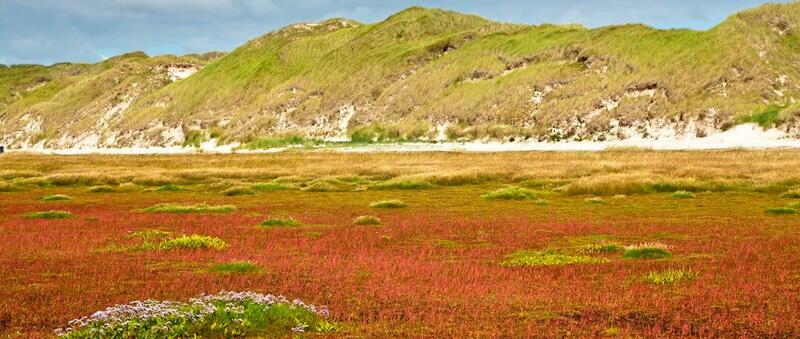Salt marshes and dunes

Salt marshes
Wadden Sea salt marshes are naturally open grasslands with habitat specific plants of great beauty and diversity. Salt marshes show a great variety of appearances: They can be rich in flowers, they can exhibit a rather diverse mixed assemblage of specialized plants and generalists adapted to disturbed regimes or they can be completely dominated by one or two grass species forming monotypic stands of vegetation. In general, diversity increases from the pioneer zone to the rarely submerged upper salt marsh belt. Highest diversity is found in sandy salt marshes and in the transition zone to dunes. Ranges of salt marsh plant populations are generally limited in the seaward direction by their ability to withstand marine inundations. In the landward direction, they tend to be limited by competition, particularly shading by other plants. The size of the Wadden Sea salt marshes is more than 400 km².
Beaches and dunes
Beaches and coastal dunes together constitute one morphogenetic habitat system. Sand blown by wind in the landward direction from the dry parts of beaches becomes trapped by various pioneer plants. In the Wadden Sea, the main dune generating species is the marram grass (Ammophila arenaria) with the ability to grow upwards with the accumulating sand. However, marram grass does not fix the sand entirely. Aeolian transport of sand continues, albeit at a lower rate. It may happen that one dune overtops another, which may lead to dune heights exceeding 20 m. Above that height, however, wind forces become too strong for marram grass to slow down sand transport and bare migrant dunes arise. These usually travel from west to east in response to the prevailing wind direction. Migrant dunes may reach the lee side of barrier islands, supplying beaches and tidal flats there with new sand. Ecologically, beaches and dunes are linked to the other habitats, not only by sand transport but in particular by birds, which rely on beaches and dunes as important foraging, nesting and resting habitats. More than 200 km² dunes are mapped in the Wadden Sea Area.
Salt Marsh and Dunes Expert Group
In the framework of the Trilateral Wadden Sea Cooperation, the Salt Marsh and Dunes Expert Group is formed with national coordinators responsible for trilateral salt marsh and dunes monitoring and meets once a year. Results on monitoring and projects are published in thematic reports and Quality Assessment reports.

